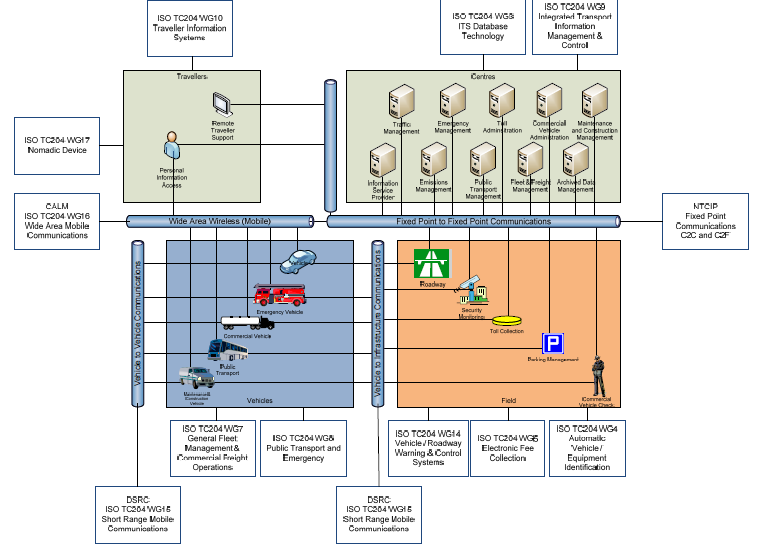
Road Network Operations
& Intelligent Transport Systems
A guide for practitioners!

Road Network Operations
& Intelligent Transport Systems
A guide for practitioners!
The process of implementing standards within a road network operation must be approached systematically:
Step 1 – Identify – where standards should be used. It is preferable to use standardised systems wherever possible – but it may not be feasible to standardise every aspect of every system, for a variety of practical reasons such as cost, availability of appropriate solutions,
Step 2 – Determine – whether appropriate standards and examples of practice already exist. Standards development is expensive – and substantial efficiencies may be gained by learning from existing practice,
Step 3 – Assess – vendor offerings to determine standards compliance.
System architecture can be used to identify where standards are needed – now and in the future. System architecture is a conceptual framework that shows how different components in a system should fit together. It also shows the key processes which require a standardised interface – especially for communications and data exchange. The figure below illustrates this.
The ITS architecture provides the context for standards development by defining the different subsystems and the data that has to flow between them. The architecture can also help identify whether the various standards should be local, regional, national, or international. This will depend on the relevant interfaces and an analysis of operational needs, user requirements and hardware/software specifications. (See ITS Architecture)

Once the need for a standard has been identified, it is important to determine whether such a standard already exists or must be developed. Many ITS standards have already been written – and additional standards development is underway in a broad range of organisations worldwide. Research of existing standards work identifies existing standards and standards in the making. The websites of the major standards organisations provide an initial set of sources to investigate. (See Standards Organisations)
Many major standards have significant user communities that can assist new users. The relevant national or regional ITS organisation will have suitable contacts. Practitioners who have already implemented ITS standards in the field are often happy to share valuable lessons learned. Many standards development organisations have resources to help connect new users to sources of help and standards training.
The standards required may not exist. If this is the case, it is important to assess the costs and benefits of embarking on a standards development exercise with the appropriate standards development body. For a rapidly developing field such as ITS, the timing of standard setting is particularly important. Premature standards setting risk stiffling innovation.
Once standards are established, consideration needs to be given to how existing systems can migrate to the new standards over a reasonable period of time. Users who have already invested in systems are reluctant to switch to new standards before they have achieved a reasonable return on their investment. Public and private organisations need to work together to promote standards that:
It is important to recognise that products and services developed to the same standard – by different manufacturers and vendors – are not automatically guaranteed to work together properly. Interoperability failures can arise from unclear standards documentation, multiple options within a standard, or partial, rather than complete standards conformity.
One example of the interoperability challenge is the attempt to demonstrate a single vehicle’s interaction with two different European cooperative system field trials – FOTsis (http://www.fotsis.com/) and DRIVE C2X (http://www.drive-c2x.eu/project). Both prototypes were designed to be fully standards compliant – but in practice, testing showed that they were not sufficiently interoperable to allow a joint demonstration.
(See Diamandouros, K, et al., FOTSIS - European Field Operational Test on Safe, Intelligent and Sustainable Road Operation, IRF 17th World Meeting, 1 July 2013).
To avoid interoperability failures, it is critical to test standards by building prototypes – and to test finished products to see if they are truly interoperable. Some major standards bodies – such as the European Telecommunications Standards Institute (ETSI) – have programmes to do this. It is also often the case that independent companies take on this role. These procedures certify products as fully compliant with the standards cited. (See Equipment Certification)
It is important to investigate the level of standards conformity provided by a product to ensure that it will work properly with other products within the same system. In some cases, regulations may be put in place to require interoperability and standards compliance.
There are no definite answers to these questions, but it may help to:
There may be a gap in national expertise on new and evolving standards – and existing standards may not fully support local needs. Involvement in the international standards development process can help address both these issues – but it requires on-going resourcing that may not be available. It is essential to ensure access to useful resources that can help:
The Japan Society of Automotive Engineers (JSAE) publishes an annual report on current work in the International Standards Organisation’s ITS Technical Committee (ISO TC204). The 2014 report is available for download at www.jsae.or.jp/01info/its/2014_bro_e.pdf.
The JSAE website provides a listing of world standards organisations and their websites (See http://www.jsae.or.jp/index_e.php).